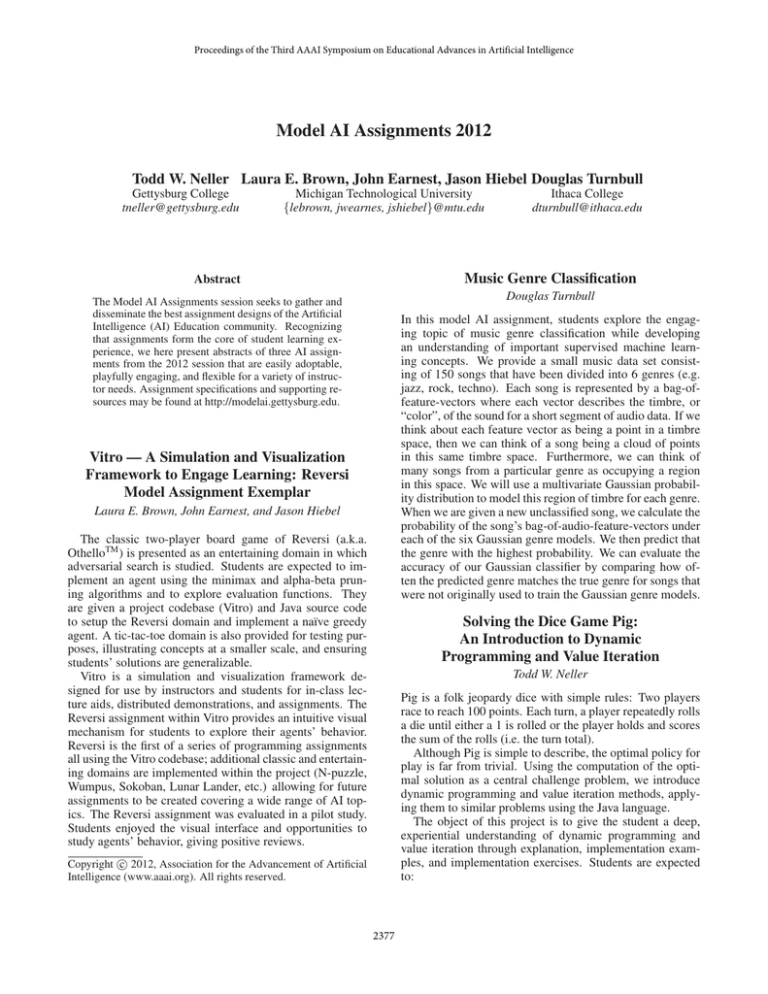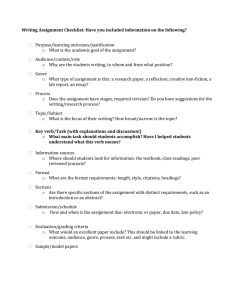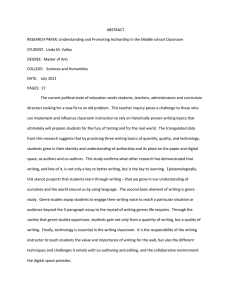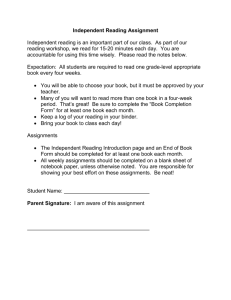
Proceedings of the Third AAAI Symposium on Educational Advances in Artificial Intelligence
Model AI Assignments 2012
Todd W. Neller Laura E. Brown, John Earnest, Jason Hiebel Douglas Turnbull
Gettysburg College
tneller@gettysburg.edu
Michigan Technological University
{lebrown, jwearnes, jshiebel}@mtu.edu
Ithaca College
dturnbull@ithaca.edu
Music Genre Classification
Abstract
Douglas Turnbull
The Model AI Assignments session seeks to gather and
disseminate the best assignment designs of the Artificial
Intelligence (AI) Education community. Recognizing
that assignments form the core of student learning experience, we here present abstracts of three AI assignments from the 2012 session that are easily adoptable,
playfully engaging, and flexible for a variety of instructor needs. Assignment specifications and supporting resources may be found at http://modelai.gettysburg.edu.
In this model AI assignment, students explore the engaging topic of music genre classification while developing
an understanding of important supervised machine learning concepts. We provide a small music data set consisting of 150 songs that have been divided into 6 genres (e.g.
jazz, rock, techno). Each song is represented by a bag-offeature-vectors where each vector describes the timbre, or
“color”, of the sound for a short segment of audio data. If we
think about each feature vector as being a point in a timbre
space, then we can think of a song being a cloud of points
in this same timbre space. Furthermore, we can think of
many songs from a particular genre as occupying a region
in this space. We will use a multivariate Gaussian probability distribution to model this region of timbre for each genre.
When we are given a new unclassified song, we calculate the
probability of the song’s bag-of-audio-feature-vectors under
each of the six Gaussian genre models. We then predict that
the genre with the highest probability. We can evaluate the
accuracy of our Gaussian classifier by comparing how often the predicted genre matches the true genre for songs that
were not originally used to train the Gaussian genre models.
Vitro — A Simulation and Visualization
Framework to Engage Learning: Reversi
Model Assignment Exemplar
Laura E. Brown, John Earnest, and Jason Hiebel
The classic two-player board game of Reversi (a.k.a.
OthelloTM ) is presented as an entertaining domain in which
adversarial search is studied. Students are expected to implement an agent using the minimax and alpha-beta pruning algorithms and to explore evaluation functions. They
are given a project codebase (Vitro) and Java source code
to setup the Reversi domain and implement a naı̈ve greedy
agent. A tic-tac-toe domain is also provided for testing purposes, illustrating concepts at a smaller scale, and ensuring
students’ solutions are generalizable.
Vitro is a simulation and visualization framework designed for use by instructors and students for in-class lecture aids, distributed demonstrations, and assignments. The
Reversi assignment within Vitro provides an intuitive visual
mechanism for students to explore their agents’ behavior.
Reversi is the first of a series of programming assignments
all using the Vitro codebase; additional classic and entertaining domains are implemented within the project (N-puzzle,
Wumpus, Sokoban, Lunar Lander, etc.) allowing for future
assignments to be created covering a wide range of AI topics. The Reversi assignment was evaluated in a pilot study.
Students enjoyed the visual interface and opportunities to
study agents’ behavior, giving positive reviews.
Solving the Dice Game Pig:
An Introduction to Dynamic
Programming and Value Iteration
Todd W. Neller
Pig is a folk jeopardy dice with simple rules: Two players
race to reach 100 points. Each turn, a player repeatedly rolls
a die until either a 1 is rolled or the player holds and scores
the sum of the rolls (i.e. the turn total).
Although Pig is simple to describe, the optimal policy for
play is far from trivial. Using the computation of the optimal solution as a central challenge problem, we introduce
dynamic programming and value iteration methods, applying them to similar problems using the Java language.
The object of this project is to give the student a deep,
experiential understanding of dynamic programming and
value iteration through explanation, implementation examples, and implementation exercises. Students are expected
to:
c 2012, Association for the Advancement of Artificial
Copyright Intelligence (www.aaai.org). All rights reserved.
2377
• Demonstrate the need for dynamic programming through
Fibonacci number computation.
• Study the details of a dynamic programming Java solution
to a simple Pig variant with an acyclic state space.
• Apply the same dynamic programming technique to one
of three novel exercises.
• Study the details of a value iteration Java solution to a
simple coin variant of Pig called Piglet.
• Apply the same value iteration technique to one of three
novel exercises.
2378





